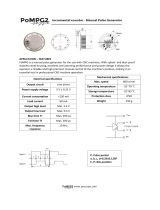
·4·
Installation manual
CNC 8037
SOFT: V02.2X
6.4 Feedback systems....................................................................................................... 216
6.4.1 Counting speed limitation......................................................................................... 217
6.4.2 Resolution ................................................................................................................ 218
6.5 Axis setting .................................................................................................................. 222
6.5.1 Drive adjustment ...................................................................................................... 223
6.5.2 Gain setting.............................................................................................................. 224
6.5.3 Proportional gain setting .......................................................................................... 225
6.5.4 Feed-forward gain setting ........................................................................................ 226
6.5.5 Derivative (AC-forward) gain setting ........................................................................ 227
6.5.6 Leadscrew backlash compensation. ........................................................................ 228
6.5.7 Leadscrew error compensation................................................................................ 229
6.5.8 Circle geometry test ................................................................................................. 231
6.6 Reference systems ...................................................................................................... 233
6.6.1 Machine reference (home) search ........................................................................... 234
6.6.2 Setting on systems without distance-coded feedback ............................................. 237
6.6.3 Setting on systems with distance-coded feedback .................................................. 239
6.6.4 Axis travel limits (software limits) ............................................................................. 240
6.7 Unidirectional approach ............................................................................................... 241
6.8 Auxiliary M, S, T function transfer................................................................................ 242
6.8.1 Transferring M, S, T using the AUXEND signal ....................................................... 244
6.8.2 Transferring the auxiliary (miscellaneous) M functions without the AUXEND signal .. 245
6.9 Spindle......................................................................................................................... 246
6.9.1 Spindle types ........................................................................................................... 246
6.9.2 Spindle speed (S) control......................................................................................... 247
6.9.3 Spindle gear change ................................................................................................ 249
6.9.4 Spindle in closed loop .............................................................................................. 251
6.10 Treatment of emergency signals ................................................................................. 257
6.11 Digital CAN servo ........................................................................................................ 260
6.11.1 Communication channels......................................................................................... 260
6.11.2 Drive’s absolute feedback........................................................................................ 263
6.12 Fagor handwheels: HBA, HBE and LGB .................................................................... 264
6.13 Machine safety related functions ................................................................................. 268
6.13.1 Maximum machining spindle speed......................................................................... 268
6.13.2 Cycle start disabled when hardware errors occur.................................................... 269
6.14 Tool magazine ............................................................................................................. 270
6.14.1 Tool change via PLC................................................................................................ 270
6.14.2 Tool magazine management ................................................................................... 271
6.14.3 Additional information for magazine management................................................... 272
6.14.4 Anticipated tool management .................................................................................. 273
6.15 Gear ratio management on axes and spindle.............................................................. 275
6.15.1 Example of axes: encoder in the motor ................................................................... 276
6.15.2 Example of axes: external encoder without gear ratio ............................................. 277
6.15.3 Example of axes: external encoder with gear ratio .................................................. 280
6.15.4 Example of spindle: encoder in the motor................................................................ 282
6.15.5 Example of spindle: external encoder without gear ratio ......................................... 284
6.15.6 Example of spindle: external encoder with gear ratio .............................................. 286
6.16 Auto-adjustment of axis machine parameter DERGAIN.............................................. 288
6.17 Compensation of the elastic deformation in the coupling of an axis ............................ 290
CHAPTER 7 PLC RESOURCES
7.1 Inputs ........................................................................................................................... 295
7.2 Outputs ........................................................................................................................ 296
7.3 Marks ........................................................................................................................... 297
7.4 Registers...................................................................................................................... 299
7.5 Timers.......................................................................................................................... 300
7.5.1 Monostable mode. Input TG1 .................................................................................. 303
7.5.2 Delayed activation mode. TG2 input........................................................................ 305
7.5.3 Delayed deactivation mode. Input TG3.................................................................... 307
7.5.4 Signal limiting mode. Input TG4............................................................................... 309
7.6 Counters ...................................................................................................................... 311
7.6.1 Operating mode of a counter ................................................................................... 314
CHAPTER 8 INTRODUCTION TO THE PLC
8.1 PLC Resources............................................................................................................ 316
8.2 PLC program execution ............................................................................................... 317
8.3 Cycle time .................................................................................................................... 320
8.4 Modular structure of the program ................................................................................ 321
8.4.1 First Cycle module (CY1)......................................................................................... 322
8.4.2 Main module (PRG) ................................................................................................. 323
8.4.3 Periodic execution module (PE t)............................................................................. 324
8.4.4 Priority of execution of the PLC modules................................................................. 325

























